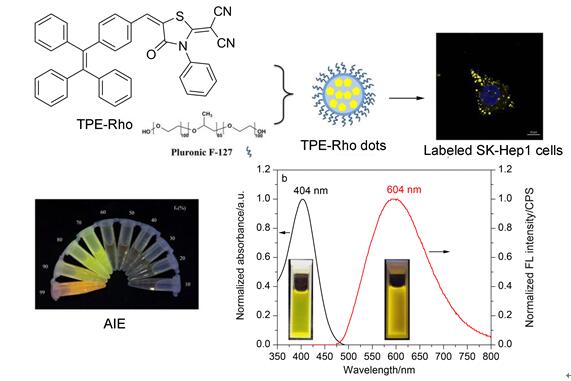| [1] Yan, L.; Zhang, Y.; Xu, B.; Tian, W. Nanoscale 2016, 8, 2471.
[2] Su, S.; Ma, Y.; Tian, L.; Wang, Z. Sci. Sin. Chim. 2017, 47, 1075(in Chinese) (苏姗, 马宇帆, 田立枚, 王卓, 中国科学:化学2017, 47, 1075.)
[3] Chen, X.; Ko, S. K.; Kim, M. J.; Shin, I.; Yoon, J. Chem. Commun. 2010, 46, 2751.
[4] Yuan, L.; Lin, W.; Zheng, K.; Zhu, S. Acc. Chem. Res. 2013, 46, 1462.
[5] Gao, M.; Hu, Q.; Feng, G.; Tang, B. Z.; Liu, B. J. Mater. Chem. B 2014, 2, 3438.
[6] Mei, J.; Leung, N. L.; Kwok, R. T.; Lam, J. W.; Tang, B. Z. Chem. Rev. 2015, 115, 11718.
[7] Ma, X.; Sun, R.; Cheng, J.; Liu, J.; Gou, F.; Xiang, H.; Zhou, X. J. Chem. Educ. 2015, 93, 345.
[8] Shi, C.; Guo, Z.; Yan, Y.; Zhu, S.; Xie, Y.; Zhao, Y. S.; Zhu, W.; Tian, H. ACS Appl. Mater. Interfaces 2013, 5, 192.
[9] Luo, J.; Xie, Z.; Lam, J. W. Y.; Cheng, L.; Tang, B. Z.; Chen, H.; Qiu, C.; Kwok, H. S.; Zhan, X.; Liu, Y.; Zhu, D. Chem. Commun. 2001, 1740.
[10] Shi, H.; Kwok, R. T.; Liu, J.; Xing, B.; Tang, B. Z.; Liu, B. J. Am. Chem. Soc. 2012, 134, 17972.
[11] Zhan, C.; You, X.; Zhang, G.; Zhang, D. Chem. Rec. 2016, 16, 2142.
[12] Liang, J.; Kwok, R. T.; Shi, H.; Tang, B. Z.; Liu, B. ACS Appl. Mater. Interfaces 2013, 5, 8784.
[13] Chatterjee, A.; Khandare, D. G.; Saini, P.; Chattopadhyay, A.; Majik, M. S.; Banerjee, M. RSC Adv. 2015, 5, 31479.
[14] Chen, Q.; Bian, N.; Cao, C.; Qiu, X. L.; Qi, A. D.; Han, B. H. Chem. Commun. 2010, 46, 4067.
[15] Li, P. F.; Liu, Y. Y.; Zhang, W. J.; Zhao, N. ChemistrySelect 2017, 2, 3788.
[16] Wu, J.; Sun, S.; Feng, X.; Shi, J.; Hu, X. Y.; Wang, L. Chem. Commun. 2014, 50, 9122.
[17] Dong, Y.; Lam, J. W. Y.; Qin, A.; Liu, J.; Li, Z.; Tang, B. Z.; Sun, J.; Kwok, H. S. Appl. Phys. Lett. 2007, 91, 1404.
[18] Hu, R.; Lager, E.; Aguilaraguilar, A.; Liu, J.; Lam, J. W. Y.; Sung, H. H. Y.; Williams, I. D.; Zhong, Y.; Wong, K. S.; Peñacabrera, E. J. Phys. Chem. C 2009, 113, 15845.
[19] Cai, Y.; Li, L.; Wang, Z.; Sun, J. Z.; Qin, A.; Tang, B. Z. Chem. Commun. 2014, 50, 8892.
[20] Huang, Y.; Lei, L.; Zheng, C.; Wei, B.; Zhao, Z.; Qin, A.; Hu, R.; Tang, B. Z. Acta Chim. Sinica 2016, 74, 885(in Chinese). (黄玉章, 雷洛奇, 郑超, 危博, 赵祖金, 秦安军, 胡蓉蓉, 唐本忠, 化学学报, 2016, 74, 885.)
[21] Lou, X.; Zhuang, Y.; Zuo, X.; Jia, Y.; Hong, Y.; Min, X.; Zhang, Z.; Xu, X.; Liu, N.; Xia, F.; Tang, B. Z. Anal. Chem. 2015, 87, 6822.
[22] Zhuang, Y.; Huang, F.; Xu, Q.; Zhang, M.; Lou, X.; Xia, F. Anal. Chem. 2016, 88, 3289.
[23] Ji, G.; Yan, L.; Wang, H.; Ma, L.; Xu, B.; Tian, W. Acta Chim. Sinica 2016, 74, 917(in Chinese). (纪光, 闫路林, 王慧, 马莲, 徐斌, 田文晶, 化学学报, 2016, 74, 917.)
[24] Leung, C. W. T.; Hong, Y.; Chen, S.; Zhao, E.; Lam, J. W. Y.; Tang, B. Z. J. Am. Chem. Soc. 2013, 135, 62.
[25] Hu, F.; Huang, Y.; Zhang, G.; Zhao, R.; Yang, H.; Zhang, D. Anal. Chem. 2014, 86, 7987.
[26] Xiong, L.; Guo, Y.; Zhang, Y.; Cao, F. J. Mater. Chem. B 2015, 4, 202.
[27] Wu, W. C.; Chen, C. Y.; Tian, Y.; Jang, S. H.; Hong, Y.; Liu, Y.; Hu, R.; Tang, B. Z.; Lee, Y. T.; Chen, C. T. Adv. Funct. Mater. 2010, 20, 1413.
[28] Zhang, X.; Liu, M.; Yang, B.; Zhang, X.; Chi, Z.; Liu, S.; Xu, J.; Wei, Y. Polym. Chem. 2013, 4, 5060.
[29] Zhang, X.; Liu, M.; Yang, B.; Zhang, X.; Wei, Y. Colloids Surf., B 2013, 112, 81.
[30] Zhang, F.; Di, Y.; Li, Y.; Qi, Q.; Qian, J.; Fu, X.; Xu, B.; Tian, W. Dyes Pigm. 2017, 142, 491.
[31] Zhang, J.; Li, C.; Zhang, X.; Huo, S.; Jin, S.; An, F. F.; Wang, X.; Xue, X.; Okeke, C. I.; Duan, G.; Guo, F.; Zhang, X.; Hao, J.; Wang, P. C.; Zhang, J.; Liang, X. J. Biomaterials 2015, 42, 103.
[32] An, F.-F.; Yang, Y.-L.; Liu, J.; Ye, J.; Zhang, J.-F.; Zhou, M.-J.; Zhang, X.-J.; Zheng, C.-J.; Liang, X.-J.; Zhang, X.-H. RSC Adv. 2014, 4, 6120.
[33] Liu, J.; Li, K.; Liu, B. Adv. Sci. (Weineim, Ger.) 2015, 2, 1500008.
[34] Rossetti, R.; Nakahara, S.; Brus, L. E. J. Chem. Phys. 1998, 79, 1086.
[35] Yuan, F.; Li, S.; Fan, Z.; Meng, X.; Fan, L.; Yang, S. Nano Today 2016, 11, 565.
[36] Yuan, X.; Luo, Z.; Yu, Y.; Yao, Q.; Xie, J. Chem. Asian J. 2013, 8, 858.
[37] Niu, X.; Chen, H.; Wang, Y.; Wang, W.; Sun, X.; Chen, L. ACS Appl. Mater. Interfaces 2014, 6, 5152.
[38] Leung, C. W. T.; Yuning, H.; Sijie, C.; Engui, Z.; Lam, J. W. Y.; Ben Zhong, T. J. Am. Chem. Soc. 2013, 135, 62.
[39] Reddy, E. R.; Yellanki, S.; Medishetty, R.; Konada, L.; Alamuru, N. P.; Haldar, D.; Parsa, K. V. L.; Kulkarni, P.; Rajadurai, M. ChemNanoMat 2016, 1, 567.
[40] Zhang, X.; Zhang, X.; Wang, S.; Liu, M.; Tao, L.; Wei, Y. Nanoscale 2013, 5, 147. |
